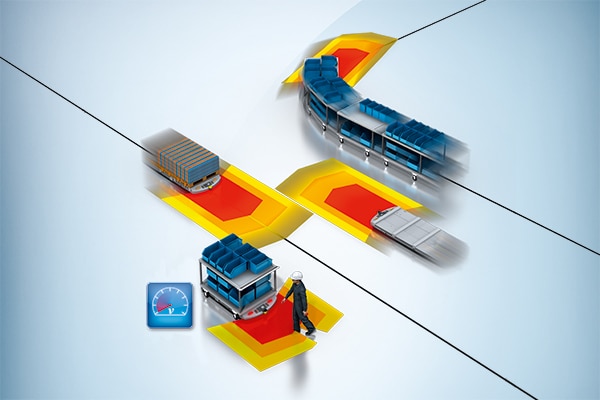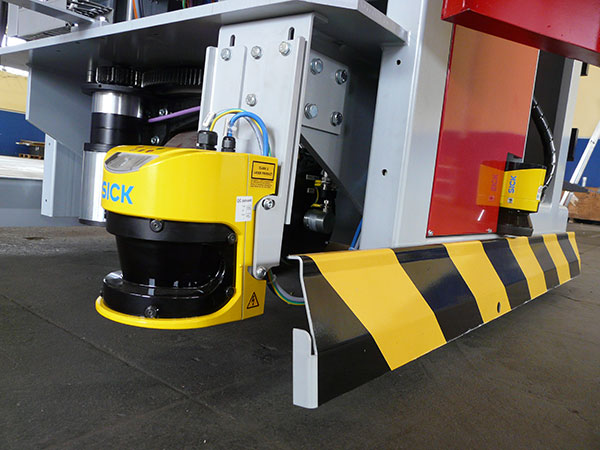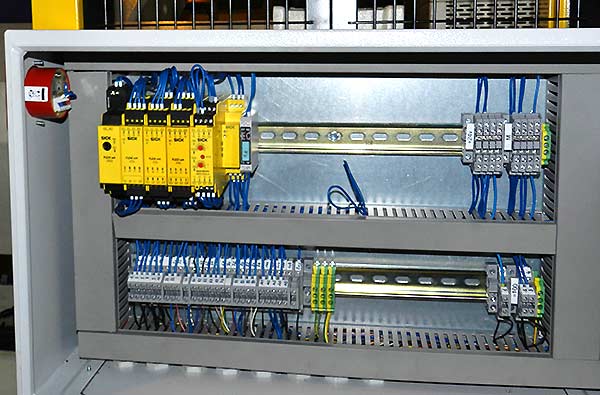Automated guided vehicles (AGVs) and automated guided vehicle systems (AGVSs) play a major role in increasing the flexibility of production and logistics processes. Used individually or in groups, these mobile helpers are the technical pioneers of cyber-physical production systems in the Industry 4.0 and Smart Factory framework - with the AGVs driving and working autonomously and AGVSs serving as self-organizing and self-optimizing units.

Implementing AGV and AGVS functionality involves the use of safety components as well as the completion of appropriate hazard analyses in advance. This is the only way to ensure the necessary level of accident prevention while also eliminating potential liability risks for manufacturers and operating entities. In this setting, safety is certainly the most important aspect, but not the only one to consider. Protective devices should not impair the vehicles use, and adding intelligent functions can provide users with additional benefits.
For example, the S300 and S3000 compact safety laser scanners not only monitor the path of an AGV, they do so while also supplying measurement data. This data gives vehicles the ability to autonomously lift and place pallets or containers and keep their cargo in the correct position. In addition, the measurement data can be used for localization in the vehicles navigation support. With the excellent scanning range of an S3000 Expert, it is also possible to detect position reflectors within a plant, and thereby determine the distance and angle in relation to the vehicle and use this measurement data for localization. Safety technology combined with measurement technology - the two examples described above show how intelligent measurement data evaluation functionality eliminates the need for additional sensors.
 S3000 in action.
S3000 in action.
Localization on Contour: navigation without reflector marks
The synergy effect of using an array of highly diverse sensors can be seen from the example of Localization on Contour (LOC) on the basis of the NAV-LOC concept. Here, 2D LiDAR sensors and safety laser scanners supply measurement data. Actual vehicle positions are calculated based on both this ambient data and a reference map created beforehand. When the sensors are combined with intelligent hardware, like the Sensor Integration Machine (SIM) from SICK, and the algorithm of the SICK Contour Localization app, the vehicle position is determined and sent to the AGV.
Flexi Soft safety controller: the safety control center that comes along for the ride
Flexi Soft is a powerful modular safety controller that is easy to put into operation. Thanks to its scalability and user-friendly software, it can be adapted efficiently to suit the requirements of all kinds of safety applications. For this purpose, its features include function modules that can be flexibly combined, software-supported logic functions, and extended options for fieldbus integration via gateways for all common fieldbuses. When used on an AGV, Flexi Soft coordinates all of the sensors and functions used to ensure the vehicles safety. With EFI (enhanced function interface), up to four safety sensors can be connected at a time. Thus, the all-around AGV protection that is particularly important for larger vehicles, for example, can be provided by using multiple safety laser scanners. In addition to areas lying in the path of the vehicle, the laser scanners also identify objects located next to the vehicle that can pose hazards during swivel movements or curve maneuvers.
 Flexi Soft safety controller.
Flexi Soft safety controller.
In order to switch the protective fields of safety laser scanners based on the vehicle speed, Flexi Soft uses the data supplied by safety encoders like the DFS60S from SICK. If information such as the steering angle or the height of the load-carrying unit are relevant for safety and control, safe inductive sensors can also be connected to Flexi Soft. Aside from safety data, Flexi Soft is able to also process information from non-safety sensors to deliver even more added value.
Monitoring and controlling AGV drive units safely
Thanks to the modular Flexi Soft concept, the safety of AGV drive units can also be monitored using the appropriate modules. For this task, SICK offers a number of different options, including the Flexi Soft Drive Monitor Motion Control safety controller, which can be used to perform many safe drive-monitoring functions on an AGV. For example, with the SSM (safe speed monitor) and SLS (safely-limited speed) safety functions, the speed of an AGV can be monitored safely via encoders on the wheels. Based on the speed, the warning and protective fields of the safety laser scanners installed on the vehicle can be switched. If the warning fields are violated, a safe reduction of speed is automatically triggered. If a protective field is violated, the SBC (safe brake control) and SS1 (safe stop 1) or SS2 (safe stop 2) drive monitoring functions intervene to activate and monitor a safe stop function for the vehicle. Once the control has activated a stop function for the AGV, the SDI (safe direction) blocks the rotational direction just having been used by the drive. As a result, the vehicle is only able to move in the unblocked direction, and thus distances itself safely from the obstacle. This means that a fully integrated solution for drive safety monitoring is available in the Flexi Soft Drive Monitor Motion Control safety controller.
AGV safety technology as a data collector for Industry 4.0
Especially when networked to provide complete safety solutions, safe sensors and safety controllers supply a wide range of additional data that can optimize the availability of individual automated guided vehicles and even an entire AGVS. Data for current consumption, operating hours, accumulated contamination, and operating temperatures are just a few examples of the information that can be directly relevant to preventative or operational maintenance as part of a condition monitoring system. This information is provided by sensors, evaluated and processed by the control unit, and sent to the vehicle control system via the gateway. From there, it is made available in higher-level or cloud-based applications by radio data transmission, Bluetooth, or NFC.
- Product information: Flexi Soft, DFS60S, Sensor Integration Machine, S300, S3000
- Product portfolio: Safety laser scanners, Encoder

